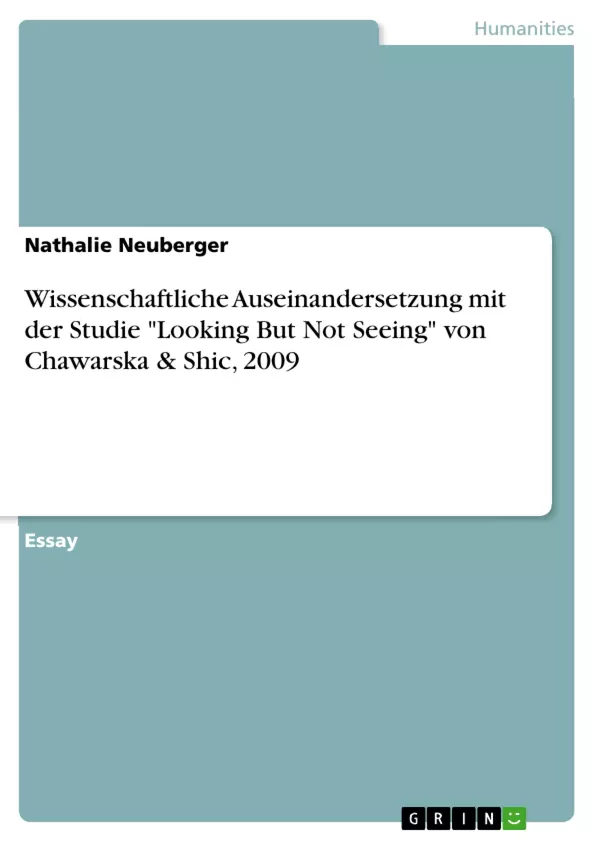Wissenschaftliche Auseinandersetzung mit der Studie "Looking But not Seeing: Atypical Scanning and Recognition of Faces in 2 and 4-Year-Old Children with Autism Spectrum Disorder" von Chawarska & Shic (2009). Mittels Eye-Tracking wurden gesunde Kinder im Vergleich zu Kindern mit einerAutismus Spektrum Störung (ASD) im Alter von 2 und 4 Jahren beim Erkennen von Gesichtern untersucht.
Die jüngeren Kindern zeigten keine Unterschiede in der Gesichtserkennung. 4-jährige Kleinkinder mit ASD schauten mit zunehmenden Alter zunehmend von Gesichtern weg und waren in der Gesichtserkennung beeinträchtigt. Es werden Implikationen und Konsequenzen der vernachlässigten Gesichtserkennung für ASD diskutiert.
Inhaltsverzeichnis (Table of Contents)
- Introduction
- Looking but not seeing
- Method
- Results
- What do the results suggest?
- General issues with research
- Literature
Zielsetzung und Themenschwerpunkte (Objectives and Key Themes)
The study "Looking But Not Seeing: Atypical Scanning and Recognition in Faces in Two- and Four-year-old Children with Autism Spectrum Disorder" aims to investigate visual scanning and recognition of faces in young children with Autism Spectrum Disorder (ASD). The study specifically examines how face processing in ASD is affected early in development and what changes with age. Additionally, the study investigates if deficits in recognition can be associated with imbalanced attention between key facial features.
- Face processing in children with ASD
- Developmental changes in face processing in ASD
- Relationship between attention to facial features and recognition ability
- Atypical scanning patterns in children with ASD
- The role of experience in face processing development
Zusammenfassung der Kapitel (Chapter Summaries)
- Introduction: Introduces the concept of Autism Spectrum Disorder (ASD) and its subclassifications. Discusses the importance of direct observation and combination of approaches for diagnosis. Highlights the need for research focusing on early developmental changes in face processing in children with ASD.
- Looking but not seeing: Outlines the study's hypothesis that children with ASD will distribute their attention between facial features differently than typically developing children. Explains the rationale behind the study's design, including the two diagnostic groups (typically developing and ASD) and the four age groups (two- and four-year-olds).
- Method: Details the assessments used to measure the comprehensive level of functioning in the ASD groups, including the Social Affective Score, the Stereotyped and Repetitive Behavior Score, and the Nonverbal and Verbal Developmental Quotient Score. Describes the stimuli used in the eye-tracking experiment, the calibration procedure, and the familiarization and recognition phases.
- Results: Reports findings regarding children with ASD's attention to facial features during familiarization and recognition phases. Highlights the association between familiarization and recognition in both typically developing and ASD groups.
- What do the results suggest?: Discusses the implications of the findings, supporting the study's hypothesis that children with ASD distribute their attention between facial features differently. Explores possible causes for the results, including limited experience-dependent specialization in the face processing system. Suggests potential intervention strategies and directions for future research.
Schlüsselwörter (Keywords)
The main keywords and focus topics of the text include Autism Spectrum Disorder (ASD), face processing, visual scanning, recognition, attention, developmental changes, atypical social experiences, early intervention, experience-dependent specialization, holistic face processing, feature-based face processing, and eye-tracking.
- Citation du texte
- Nathalie Neuberger (Auteur), 2017, Wissenschaftliche Auseinandersetzung mit der Studie "Looking But Not Seeing" von Chawarska & Shic, 2009, Munich, GRIN Verlag, https://www.grin.com/document/501947



